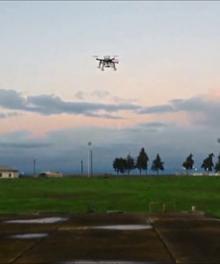Peek in the windows at the Mechatronics, Embedded Systems and Automation (MESA) Lab sometime. You will probably see students flying small remote-controlled vehicles at all hours of the day and night.
Sometimes the students are having so much fun they have to be pushed to go home and sleep.
But what seems like a hobby or diversion is actually serious research.
The students are learning to fly these small vehicles indoors so they can better understand how to manipulate the flight patterns of unmanned aerial vehicles (UAVs) that will be used outdoors.
The plan is to use the UAVs – which are programmed for specific autonomous flights instead of being remote controlled by users – in many different ways, from monitoring agricultural fields to detecting natural gas leaks along miles of pipelines.
Students are working to refine systems that deliver high-precision technology to a wider variety of users, including farms that could use the small planes to monitor crop growth, soil health, moisture levels and even deliver extra fertilizer to areas of fields that need special care.
It’s one more way UC Merced’s cutting-edge research will benefit society.
“This is not a dream – it’s very possible,” said School of Engineering Professor YangQuan Chen, who runs the MESA Lab. “We are finding ways to bring technology to the people who need it.”
Using unmanned aerial vehicles would allow a company or agency to monitor conditions that would take a person much more time and effort. The UAVs are small – they have wingspans from 3 feet to 10 feet – are far less expensive than hiring a human to do the work, are more able to access remote areas, can carry high-tech equipment like high-resolution cameras and sensors, and, as Chen said, “you don’t cry if a UAV crashes.”
In fact, crashes are inevitable.
The researchers just want to learn to get the maximum use from the UAVs before the inevitable happens.
Learning how to do that requires them to be creative. For example, the researchers want an inflatable pool for their lab so they can learn to land a UAV in water, collect samples and take off again.
They want a meat smoker not only to hold their monthly “Robotics and Ribs” gatherings where they will eat, talk about their work and hone their presentation skills, but fly UAVs over the smoker to learn to program them to detect the kinds of temperature fluctuations that signal natural gas leaks.
“It’s not just pure robotics, it’s an entire system to work with,” said lab Manager and Ph.D. student Brandon Stark.
The study is called mechatronics – the blend of mechanical engineering, electronics, computers and controls – and it’s becoming quite a draw on campus.
The MESA Lab started in August and has already attracted 13 undergraduates, two Ph.D. graduate students and three visiting scholars working on dozens of different research projects.
Lab leaders are working on research-funding agreements with different agencies and companies that want to use the technology these students are developing.
Chen wants to put mechatronics to work solving sustainability issues, as well, and he and his students work with UC Solar, one of their neighbors at the Castle Research Facility.
This spring, they are building one of Professor Roland Winston’s patented inventions, a heliotropic solar collection cell that would make solar collection more energy efficient and less expensive, and make it possible to have solar arrays in places it wasn’t before.
The design uses the collection cell to track the sun the way entire solar panels have done in the past. Having only one small moving mechanism means space and energy efficiency, and fewer moving parts that could break down.
Undergraduate student Grant McGregor said he joined the MESA Lab because he has always had a passion for robotics, and likes the idea of building and using the robots to solve real-life challenges.
He’s one of the students on a team that will travel to Maryland this summer for an international competition featuring student-designed unmanned aerial systems through The Association for Unmanned Vehicle Systems International (AUVSI). Winners earn cash prizes the students can share. Chen’s teams at Utah State, where he worked before UC Merced, won the competition twice, so he’s certain his students here can do the same.
They’ve already won the first place award for “Click&Move® Motion and Automation Design Contest” for the virtual design of the heliotropic solar collector system and shared a $4,000 cash prize.
“That gave me real confidence in the students at UC Merced,” Chen said. “They are very dedicated, very highly motivated.”



